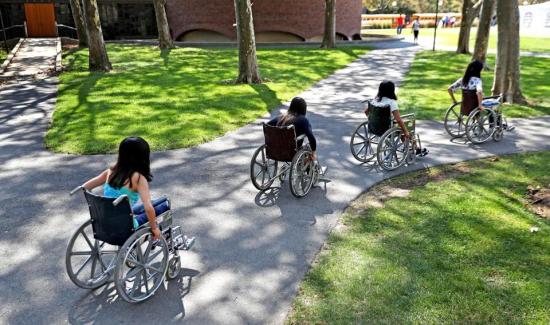
Able-bodied MIT students used wheelchairs to get around the Cambridge campus last week. Photo by David L. Ryan/Boston Globe.
Once a year for two hours, a group of able-bodied students at the Massachusetts Institute of Technology takes to the streets of Cambridge and their campus halls in wheelchairs.
During another two-hour class period, they walk around the classroom wearing goggles wrapped in duct tape and plastic wrap to simulate different levels of visual impairment.
That’s because they’re enrolled in HST 420/6.811/2.78 Principles and Practice of Assistive Technology (PPAT), a course* offered every fall that gives students the chance to put themselves in the shoes of people with disabilities for a brief amount of time.
The students might be able to build roller coasters on campus and waterfalls in their fraternity houses, but when it comes to using a wheelchair or navigating hallways with impaired vision, most of them don’t know where to begin, said senior lecturer Julie Greenberg.
Greenberg, who teaches the course, said for the first two weeks, students participate in labs simulating various physical disabilities in order to better understand the needs of those who use assistive technology.
“They’re very familiar with the MIT campus, so they’re engaging in familiar activities from an entirely new perspective,” Greenberg said. “The course is designed so that for the first couple of weeks, the students are getting this . . . perspective.”
Greenberg said when she sends her students off in wheelchairs, she asks them to perform seemingly simple tasks around campus: using water fountains, sending e-mails from library computers, using public restrooms, crossing the street.
“Whenever possible, we want them to do that from the perspective of the person using the technology,” Greenberg said.
Students return to class sweaty and surprised, with aching arms and blistered hands.
“Wow, I always thought wheelchair ramps weren’t very steep,” she recalled one student saying after having picked up too much speed on the way down a ramp on campus.
Then, the students are assigned to create a working prototype of a product designed to assist people with disabilities.
“They’re going to develop assistive technology for a client, where the clients are individuals in the community who have proposed project ideas to the class,” Greenberg said.
MIT students Andrew Hall in a wheelchair got a push by Helen Abadiotakis across Massachusetts Ave. in a MIT PPAT class. Photo by David L. Ryan/Boston Globe.
They work in small groups of three or four, producing three prototypes over the course of the semester.
Greenberg said at first, the prototypes are basic and usually only represent the intended dimensions of the final products.
But by the time the students create their third models, the products are refined and ready to be used.
One group that began in a 2014 class produced an app that enables people with disabilities to send custom messages, emergency alerts, and Facetime calls to nurses in the area. The group continued to work on the project through the spring semester, Greenberg said.
The students collaborated with a woman living in the Boston Home, a facility for adults who have neurological diseases, and by the time summer rolled around, the facility was using the app to connect their residents with nurses, allowing them more freedom, according to a Globe report at the time.
The class also includes a lecture about proper etiquette when interacting with people who have disabilities in order to “sensitize” students, Greenberg said.
Guest speakers with disabilities offer advice on what language to use and how to behave physically, such as asking permission before leaning on or touching someone’s wheelchair.
Students also learn how to best engage in conversation with a person who uses a sign language interpreter or communication companion: For instance, it’s best to speak directly to the person you’re addressing, not to his or her interpreter.
And students learn to identify themselves verbally before making physical contact with a blind person and to be as specific as possible when giving directions, like telling a blind person the floor is wet instead of just telling them to look out.
This semester’s etiquette class will take place on Monday, Greenberg said.
“We’re really just trying to give students the basic background to give them what they need to go and be effective in these projects,” Greenberg said. “Whatever it is, doing it in a wheelchair is just much harder than it looks.”
MIT employee Darren Bennett held the door at the student center for MIT students in a PPAT class. Photo by David L. Ryan/Boston Globe.
Alyssa Meyers | Boston Globe: https://www.bostonglobe.com/metro/2017/09/17/mit-class-focuses-life-lived-wheels/09j1DM8O1j8MxtBLcl0IZP/story.html
*The Principles and Practice of Assistive Technology class was founded by Professor Seth Teller, who first offered it in 2011. The class is currently co-taught by Rob Miller (EECS), John Leonard (MechE), and Julie Greenberg (IMES/HST).